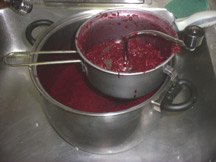
Looking for How to Make and Can Tomato Juice at Home - Easily! in 2025? Scroll down this page and follow the links. And if you bring home some fruit or vegetables and want to can, freeze, make jam, salsa or pickles, see this page for simple, reliable, illustrated canning, freezing or preserving directions. There are plenty of other related resources, click on the resources dropdown above. If you are having a hard time finding canning lids, I've used these, and they're a great price & ship in 2 days.
If you have questions or feedback, please let me know! There are affiliate links on this page. Read our disclosure policy to learn more.
How to Make and Can Tomato Juice at Home - Easily!
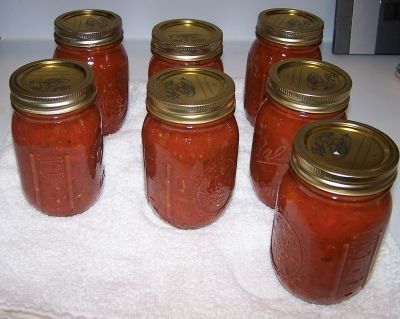 How to Make and Can Tomato Juice at Home - Easily!
How to Make and Can Tomato Juice at Home - Easily!
Click here for a PDF print
version
Making and canning your own tomato juice is also quite easy.
And imagine how much better it will taste in the winter, with the flavor of
home grown tomatoes! Just scroll down this page to see how to do it, in easy
steps and completely illustrated. I like it with the basil, but you can
also make plain tomato juice, too. The only special equipment you need is a
pressure canner and canning jars with new lids. Caution: Do not add
other vegetables or thickening agents to home canned tomato juice.) If you
want to make a
Mixed tomato-vegetable juice
(like "V8") see this page.Ingredients
- Tomatoes (any quantity - see step one)
- Lemon Juice (less than a cup)
Equipment
- Jar funnel ($5 at Target, other big box stores, and often grocery stores; and available online - see this page) or order it as part of the kit with the Jar grabber .
- Jar grabber (to pick up the hot jars)-
Big box stores and grocery stores sometimes carry them; and it is
available online - see this page. It's a tremendously useful to
put jars in the canner and take the hot jars out (without scalding
yourself!). The kit sold below has everything you need, and at a pretty
good price:
- At least 1 large pot; I prefer 16 to 20 quart Nonstick ceramic coated pots for easy cleanup.
- Large spoons and ladles,
- 1 Water Bath or Pressure Canner - see this page for more information).
- Canning jars (Grocery stores, like Publix, Kroger, Safeway carry them, as do some big box stores - about $7 per dozen 8 ounce jars including the lids and rings)
- Lids - thin, flat, round metal lids with a gum binder that seals them against the top of the jar. They may only be used once.
- Rings - metal bands that secure the lids to the jars. They may be reused many times.
Optional stuff:
- Lid lifter (has a magnet to pick the lids out of the almost-boiling water where you sanitize them. ($4 at big box stores or it comes in the kit at left)
Directions
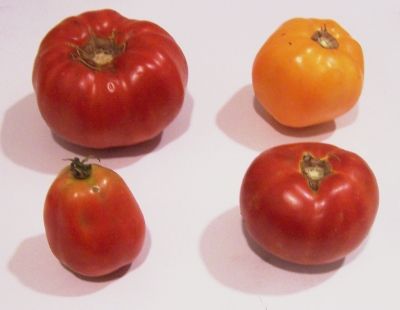 Step
1 - Selecting the tomatoes
Step
1 - Selecting the tomatoes
It's fun to go pick your own and you can obviously get better quality tomatoes!
Wash, remove stems, and trim off bruised or discolored portions of the tomatoes.
Quantity: An average of 23 pounds is needed per canner load of 7 quarts, or an average of 14 pounds per canner load of 9 pints. A bushel weighs about 53 pounds and yields 15 to 18 quarts of juice - an average of 31/4 pounds per quart.
At right is a picture of tomatoes from my garden - they are so much better than anything from the grocery store. And if you don't have enough, a pick-your-own farm is the pace to go! At right are 4 common varieties that will work:
| Top left: Beefsteak | Top right: Lemon Boy, yellow |
| Bottom left: Roma, paste-type | Bottom right: Better Boy |
Also, you don't want mushy, bruised or rotten tomatoes!
Caution: Do not can tomatoes from dead or frost-killed vines. Green tomatoes are more acidic than ripened fruit and can be canned safely, also.
Step 2 - Wash the jars and lids
 Now's
a good time to get the jars ready, so you won't be rushed later. The
dishwasher is fine for the jars; especially if it has a "sanitize" cycle,
the water bath processing will sanitize them as well as the contents! If you
don't have a dishwasher with a sanitize cycle, you can wash the containers
in hot, soapy water and rinse, then sanitize the jars by boiling them 10
minutes, and keep the jars in hot water until they are used.
Now's
a good time to get the jars ready, so you won't be rushed later. The
dishwasher is fine for the jars; especially if it has a "sanitize" cycle,
the water bath processing will sanitize them as well as the contents! If you
don't have a dishwasher with a sanitize cycle, you can wash the containers
in hot, soapy water and rinse, then sanitize the jars by boiling them 10
minutes, and keep the jars in hot water until they are used.
NOTE: If a canning recipe calls for 10 minutes or more of process time in the canner, then the jars do not need to be "sanitized" before filling them. But really, sanitizing them first is just good hygeine and common sense! See this page for more detail about cleaning and sanitizing jars and lids.
Put the lids into a pan of hot, but not quite boiling water (that's what the manufacturer's recommend) for 10 minutes, and use the magnetic "lid lifter wand" to pull them out. Leave the jars in the dishwasher on "heated dry" until you are ready to use them. Keeping them hot will prevent the jars from breaking when you fill them with the hot jam.
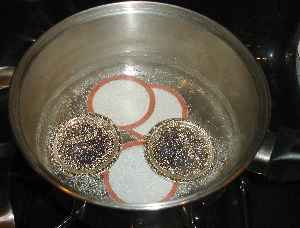 Lids:
put the lids into a pan of hot water for at least several minutes; to soften
up the gummed surface and clean the lids.
Lids:
put the lids into a pan of hot water for at least several minutes; to soften
up the gummed surface and clean the lids.
Need lids, rings and replacement jars?
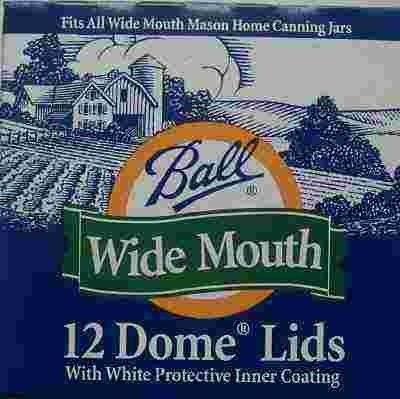
Get them all here, delivered direct to your home, at the best prices on the internet!
Step 3 - Cut up the tomatoes and quickly put into the pot
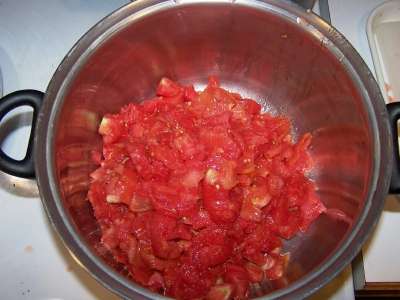 To
prevent the juice from separating, quickly cut about 1 pound of tomatoes
at a time into quarters and put directly into a saucepan on the stove.
(If you are not concerned about juice separation, simply slice or
quarter all of the tomatoes at once into a large saucepan.)
To
prevent the juice from separating, quickly cut about 1 pound of tomatoes
at a time into quarters and put directly into a saucepan on the stove.
(If you are not concerned about juice separation, simply slice or
quarter all of the tomatoes at once into a large saucepan.)
Juicers? Can you use a juicer? There is no official guidance on the use of juicers from any reputable source (Ball Blue Book., NCFHFP, Mrs. Wages Corp, etc.) I've heard informal discussion about entrained air bubbles and specks of tomato seeds, but it seems to be that these are natural parts of the fruit and process and would become uniformly dispersed and santitized in the cooking and canning, so until I see official, credible research to the countrary, I'm using the juicer... and to no ill efect!
Step 4 - Heat to boiling and keep adding tomatoes
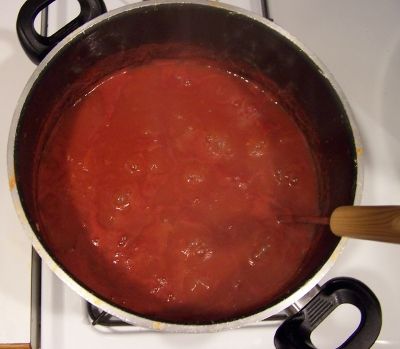 Heat
immediately to boiling while crushing (I use a potato masher). Continue to
slowly add and crush freshly cut tomato quarters to the boiling mixture;
repeating steps 4 and 5. Make sure the mixture boils constantly and vigorously
while you add the remaining tomatoes.
Heat
immediately to boiling while crushing (I use a potato masher). Continue to
slowly add and crush freshly cut tomato quarters to the boiling mixture;
repeating steps 4 and 5. Make sure the mixture boils constantly and vigorously
while you add the remaining tomatoes.
Step 5 - Continue cooking
Simmer 5 minutes after you add all pieces. Crush, heat, and simmer for 5 minutes before juicing.
Step 6 - Sieve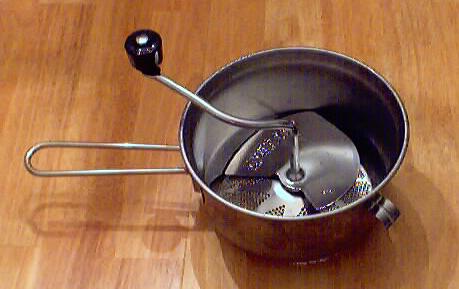
Press the heated tomato juice through a sieve or food mill to remove skins and seeds. I use the Foley food mill, shown at right
There is also a VERY nice, versatile strainer pictured at below! Click on the links there or see the bottom of this page for more information and to order! The VillaWare model can handle higher volumes than a Foley food mill (without giving you cramps!) And yes, you can use your juicer, if it can handle boiling hot liquids!
See here for related tools, equipment, supplies on Amazon See here for related tools, equipment, supplies on Amazon See here for related tools, equipment, supplies on Amazon See here for related tools, equipment, supplies on Amazon See here for related tools, equipment, supplies on Amazon
To see a greater variety of strainers in other types, sizes, and prices, click here!
Step 7 - Heat the strained tomato juice again
Heat the juice again to boiling.
Step 8 - Add lemon juice and seasoning TO EACH STILL EMPTY JAR
Add bottled lemon juice or citric acid to jars, as described in the next paragraph, to acidify the contents. This helps avoid spoilage and increase safety.
Acidification: To ensure safe acidity in whole, crushed, or juiced tomatoes, add two tablespoons of bottled lemon juice or 1/2 teaspoon of citric acid (such as "Fruit Fresh") per quart of tomatoes. For pints, use one tablespoon bottled lemon juice or 1/4 teaspoon citric acid. Acid can be added directly to the jars before filling with product. Add 1 tablespoon of sugar to offset acid taste, if desired. Four tablespoons of a 5 percent acidity vinegar per quart may be used instead of lemon juice or citric acid. However, vinegar may cause undesirable flavor changes, compared with lemon juice or citric acid.
Seasoning: Add 1 teaspoon of salt per quart to the jars, if desired. I also add 1 teaspoon of ground basil.
Step 9 - Fill the jars and put the lid and rings on
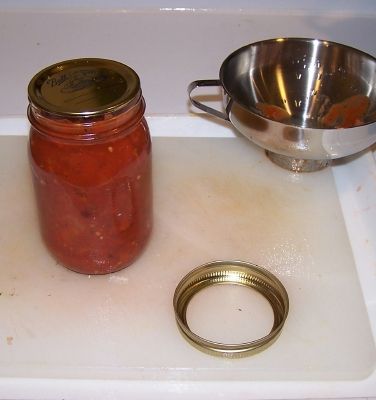 Fill
jars with hot tomato juice, leaving 1/2-inch headspace. Adjust lids and process
following to the instructions in the tables below according to the type of
canner you have. (Acidification is still required for the pressure canning
options; follow all steps in the Procedures above for any of the processing
options.)
Fill
jars with hot tomato juice, leaving 1/2-inch headspace. Adjust lids and process
following to the instructions in the tables below according to the type of
canner you have. (Acidification is still required for the pressure canning
options; follow all steps in the Procedures above for any of the processing
options.)
Note: the charts below will help you determine the right processing time and pressure, if you have a different type of canner, or are above sea level.
Water Bath Canner: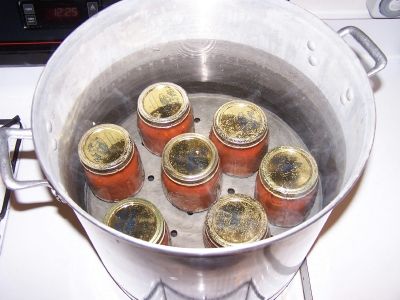
| Table 1. Recommended process time for Tomato Juice in a boiling-water canner. (shown at left) | ||||
| Hot pack | Process Time at Altitudes of | |||
| Jar Size | 0 - 1,000 ft | 1,001 - 3,000 ft | 3,001 - 6,000 ft | Above 6,000 ft |
| Pints | 35 min | 40 | 45 | 50 |
| Quarts | 40 | 45 | 50 | 55 |
Pressure canners:
| Table 2. Recommended process time for Tomato Juice in a dial-gauge pressure canner. (not shown) | |||||
| Hot pack | Canner Gauge Pressure (PSI) at Altitudes of |
||||
| Jar Size | Process Time | 0 - 2,000 ft | 2,001 - 4,000 ft | 4,001 - 6,000 ft | 6,001 - 8,000 ft |
| Pints or Quarts |
20 min | 6 lb | 7 lb | 8 lb | 9 lb |
| 15 | 11 | 12 | 13 | 14 | |
| Table 3. Recommended process time for Tomato Juice in a weighted-gauge pressure canner (not shown). | |||
| Hot pack | Canner Gauge Pressure (PSI) at Altitudes |
||
| Jar Size | Process Time | 0 - 1,000 ft | Above 1,000 ft |
| Pints or Quarts |
20 min | 5 lb | 10 lb |
| 15 | 10 | 15 | |
| 10 | 15 | Not Recommended | |
Step 10 - Remove the jars
 Lift
the jars out of the water and let them cool on a wooden cutting board or a
towel, without touching or bumping them in a draft-free place
(usually takes overnight), here they won't be bumped. You can then remove
the rings if you like, but if you leave them on, at least loosen them
quite a bit, so they don't rust in place due to trapped moisture. Once the
jars are cool, you can check that they are sealed verifying that the lid
has been sucked down. Just press in the center, gently, with your finger.
If it pops up and down (often making a popping sound), it is not sealed.
If you put the jar in the refrigerator right away, you can still use it.
Some people replace the lid and reprocess the jar, then that's a bit iffy.
If you heat the contents back up, re-jar them (with a new lid) and the
full time in the canner, it's usually ok. You're done!
Lift
the jars out of the water and let them cool on a wooden cutting board or a
towel, without touching or bumping them in a draft-free place
(usually takes overnight), here they won't be bumped. You can then remove
the rings if you like, but if you leave them on, at least loosen them
quite a bit, so they don't rust in place due to trapped moisture. Once the
jars are cool, you can check that they are sealed verifying that the lid
has been sucked down. Just press in the center, gently, with your finger.
If it pops up and down (often making a popping sound), it is not sealed.
If you put the jar in the refrigerator right away, you can still use it.
Some people replace the lid and reprocess the jar, then that's a bit iffy.
If you heat the contents back up, re-jar them (with a new lid) and the
full time in the canner, it's usually ok. You're done!
Once cooled, they're ready to store. I find they last up to 12 months. But
after about 6 to 8 months, they get darker in color and start to get runny.
They still are safe to eat, but the flavor and texture aren't as good. So
eat them in the first 6 months after you prepare them!
Summary - Typical Cost of Making Homemade Tomato Juice | ||||
| Item | Quantity | Cost in 2025 | Source | Subtotal |
| Tomatoes | 1 gallon | free from your garden | your garden or neighbor | |
| Canning jars (quart size), includes lids and rings | 12 jars | $9.00/dozen | Grocery stores, like Public, Kroger, Safeway and sometimes, Big Lots, local hardware stores and big box stores | $9.00 |
| Lemon juice | 1 cup | $1.00 | Grocery stores, like Public, Kroger, Safeway and sometimes, Big Lots, local hardware stores and big box stores | $1.00 |
| Total |
$10.00 total or about $0.83 per quart jar | |||
|
* - This assumes you already have the pots, pans, ladles,, and reusable equipment. Note that you can reuse the jars and reduce the cost further; just buy new lids (the rings are reusable, but the flat lids are not)! | ||||
This document was adapted from the "Complete Guide to Home Canning,"
Agriculture Information Bulletin No. 539, USDA, revised 1994.
Please read Using Pressure Canners and Using Boiling Water Canners before beginning. If this is your first time canning, it is recommended that you read Principles of Home Canning.
Canning Books, Supplies and Accessories
These are my favorite essential canning tools, books and supplies. I've been using many of these for over 50 years of canning! The ones below on this page are just the sampling of. my preferred tools. but you can find much more detailed and extensive selections on the pages that are linked below.
- Strainers, pit removers, seed-skin-stem removers, jelly strainers, etc. All types, makes and prices (from $19 to $350)
- Selecting a KitchenAid mixer and attachments for home canning
- Vacuum Foodsealers for freezing, dried foods, and refrigerated foods - the FoodSaver line
- Cherry pitters reviews, prices and ordering
- Steam Juicers
- Food dehydrators - easy and fast to dry your own fruits, veggies, sun-dried tomatoes, etc.
The All New Ball Book Of Canning And Preserving: Over 350 of the Best Canned, Jammed, Pickled, and Preserved Recipes Paperback
This is THE book on canning! My grandmother used this book when I was a child.; It tells you in simple instructions how to can almost anything; complete with recipes for jam, jellies, pickles, sauces, canning vegetables, meats, etc.
If it can be canned, this book likely tells you how! Click on the link below for more information and / or to buy (no obligation to buy)The New Ball Blue Book of Canning and Preserving
Canning and Preserving for Dummies by Karen Ward
This is another popular canning book. Click here for more information, reviews, prices for Canning and Preserving For Dummies
Of course, you do not need to buy ANY canning book as I have about 500 canning, freezing, dehydrating and more recipes all online for free, just see Easy Home Canning Directions.
Home Canning Kits
See here for related tools, equipment, supplies on Amazon See here for related tools, equipment, supplies on Amazon
I have several canners, and my favorite is the stainless steel one at right. It is easy to clean and seems like it will last forever. Mine is 10 years old and looks like new.
The black ones are the same type of standard canner that my grandmother used to make everything from applesauce to jams and jellies to tomato and spaghetti sauce.
This complete kit includes everything you need and lasts for years: the canner, jar rack, Jar grabber tongs, lid lifting wand, a plastic funnel, labels, bubble freer, It's much cheaper than buying the items separately. It's only missing the bible of canning, the Ball Blue Book.
You will never need anything else except jars & lids (and the jars are reusable)!
The complete list of canners is on these pages:
- Water bath canners - Good for acidic foods, like applesauce, pickles, salsa, jams, jellies, most fruits
- Pressure canners - needed for low and non-acidic foods, like canned vegetables (corn, green beans, etc), and meats
- Canners for glass top stoves if you have a glass or ceramic stove
- Canners for induction stovetops
Pressure Canners
If you plan on canning non-acidic foods and low acid foods that are not pickled - this means: meats, seafood, soups, green beans corn, most vegetables, etc., then you ABSOLUTELY must use a Pressure Canner.
Of course, you can use a pressure canner as a water bath canner as well - just don't seal it up, so it does not pressurize. This means a Pressure Canner is a 2-in-1 device. With it, you can can almost ANYTHING.
There are also other supplies, accessories, tools and more canners, of different styles, makes and prices, click here!
Basic Canning Accessories
From left to right:
- Jar lifting tongs to pick up hot jars
- Lid lifter - to remove lids from the pot of boiling water (sterilizing )
- Lids- disposable - you may only use them once
- Ring - holds the lids on the jar until after the jars cool - then you remove them, save them and reuse them
- Canning Jar funnel - to fill the jars
Strainers
These are very useful for making sauces like applesauce, tomato sauce, spaghetti sauce, jellies, etc. Below are my favorites. The complete list is on these pages:
- Strainers, pit removers, seed-skin-stem removers, jelly strainers, etc. All types, makes and prices (from $19 to $350)
- Selecting a KitchenAid mixer and attachments for home canning
Inexpensive Old School Strainers: hand cranked Foley Food Mills
- The hand-cranked Foley food mill (see this page or clock the ad box) has been used for well over 100 years in homes all over America (and variants around the world). It is effective and inexpensive, and ideal for small batches. However, if you need to make many quarts, you will sure end up with tunnel carpel syndrome or some other repetitive strain injury.
Norpro 1951 Manual Food Strainer and other brand stariners, with optional motors; (almost identical to Victorio V250, Villaware and Roma models, all discontinued)
This is The next step up from the Foley food mill. First, it's far more ergonomic, and its handle is easier to use. Next, it works in continuous mode rather than batch mode. So you can do much larger volumes easily. Finally, It has an optional motor, so you can. remove the manual labor. It also offers many different size strainers to use for different types of berries, vegetables and fruit.
See the seller's website for more information, features, pricing and user reviews!
- A Johnny, Weston or Oxo strainer (about $60 - $100, see further down the page) or
- This trainer is. simply a more upscale and improved version of the one above.
- See this page for more information, reviews, descriptions of other strainers and supplies or to order!
KitchenAid - Best Large Volume Strainers
If you're going to do large volumes of fruit or vegetables , or do it year after year, then. you really should think about getting a higher end kitchen. utility device. Kitchen aids are the cream of the crop. Once you buy one of these, you keep at the rest of your life and it gets handed down to the next generation. . My sister is using one she inherited from my mother 25 years ago, who got it in the 1940s as a wedding gift. So, although the initial cost is high, they literally last for many lifetime. So the cost on an annual basis is pretty trivial, especially when you consider the cost of therapy and treatment for. the repetitive strain injuries you will get from manual cranking day after day. Add to that of course the cost of therapy for the emotional injuries you'll get from going insane, standing there hand cranking something for hours.
KitchenAid's with a sieve/grinder (with the attachments, costs about $400, but it lasts a lifetime and is fast and easy to use - I can make 100 quart jars of applesauce per day with one of these).
FREE Illustrated Canning, Freezing, Jam Instructions and Recipes
Don't spend money on books. that you don't need to. Almost everything you can find in some book sold online or in a store is on my website here for free. Start with theEasy Home Canning Directions below. That is a master list of canning directions which are all based upon the Ball Bblue book, the National Center for Home Food Preservation and other reputable lab tested recipes. Almost every recipe I present in addition to being lab tested com. is in a step by step format with photos for each step and complete. explanations. that tell you how to do it, where to get the supplies and pretty much everything you need to know. In addition, there almost always in a PDF format so you can print them out and use them while you cook.
[ Easy Home Canning Directions]
[FAQs - Answers to common questions and problems]
[Recommended books about home canning, jam making, drying and preserving!]
Looking for canning equipment and supplies?
Water bath canner with a jar rack
Pressure canners for gas, electric and induction stoves: Presto 23Qt or T-fal 22Qt
Canning scoop (this one is PERFECT)
Ball Blue book (most recent version)
Jars: 8oz canning jars for jams
Find Other types of farms:
Farm markets and roadside stands
Road trips and camping resources
Local Honey, apiaries, beekeepers
Consumer fraud and scams information
Home canning supplies at the best prices on the internet!
Maple Syrup Farms, sugarworks, maple syrup festivals
Environmental information and resources
Farms For Your Event for birthday parties, weddings, receptions, business meetings, retreats, etc.
Festivals - local fruit and vegetable festivals
Get the
most recent version of
the Ball Blue Book
With this Presto 23 quart pressure canner and pressure cooker, you can "can" everything, fruits, vegetables, jams, jellies, salsa, applesauce, pickles, even meats, soups, stews. Model 01781

You can make jams, jellies, can fruit, applesauce, salsa and pickles with water bath canners, like this Granite Ware 12-Piece Canner Kit, Jar Rack, Blancher, Colander and 5 piece Canning Tool Set




